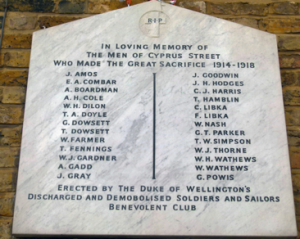Monthly Archives: March 2018
30th and 31st March 1918 Saturday and Sunday
Relief and a trek back to Merville
All material produced or reproduced here and throughout this work is the sole copyright of the author and the family of Doctor D.C.M. Page MC.
“Next day I handed over to the 102nd Field Ambulance (34th Division), and got back to L’Estrade in the early afternoon after some hustle.
Next day (Sunday 31st March) we were up early, and marched off to Merville, via Crois du Bac and Estaires. I rode most of the way, and the men marched very well in spite of being tired after so much hustling during the last few days. In Merville the men were billeted in deserted houses and we had our mess and billets in a large empty villa. Most of the houses near the railway station were badly damaged by shells and bombs, and the inhabitants had left the town hurriedly.”
Merville had at this time suffered a great deal of damage and had been almost totally destroyed, its inhabitants had largely gone. Back in November 1915 it was the area HQ for the British Army and was where Churchill had been asked to attend the aborted meeting in the incident that inadvertently saved his life.
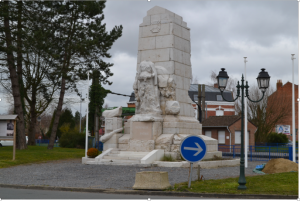
Photo © Ray Coggin. The War memorial in Merville, damaged in a subsequent Battle of the Lys in May 1940
Find out about our connection with Dr Page and an introduction to his diary here
29th March 1918 Friday
A Hurried Breakfast and Scots From The Somme
All material produced or reproduced here and throughout this work is the sole copyright of the author and the family of Doctor D.C.M. Page MC.
“I took over the Dressing Station at Erquinghem from the 131st Field Ambulance camp on the morning of the 29th, having got sudden orders at 8.35 a.m. to do so. It was some rush. I had a very hurried apology of a breakfast at 8.30, and nothing more till I had a ‘high’ tea at 4.30 p.m.
The 9th Royal Scots (Dandy Ninth), and Macrae’s Battalion came into the village at night. It was fine to see them again. They have just come north from Albert.”
“High Tea” was probably a hot meal and not a plate of scones and sandwiches with the crusts removed.
“The Dandy Ninth”, so called because their uniforms based on the Hunting Stewart tartan, set them apart from other battalions of the Royal Scots. Arriving in France in February 1915 they had earned a reputation for fighting valour having been involved at High Wood on the Somme in 1916 then in 1917 at Arras and Vimy Ridge and later at Passchendaele and Cambrai.
Having come north from Albert, on the Somme where the Germans initially broke through with great success, they would go on to be instrumental in the disruption and later halting of the German advance during the Spring Offensive.
Once the Germans had been halted it was the tipping point of the war and ultimately led to the Armistice.
McCrae’s Battalion was one of Lord Kitchener’s New Army, Pal’s battalions, raised in 1914. Known as the Sportsman’s battalion it recruited predominately from professional sportsmen that included many footballers, drawn from the main clubs in Scotland.
The whole ethos of Pal’s battalions was that men would fight alongside men they knew from private life, encouraging a stronger sense of unity resulting in men watching out for each other and becoming a more determined fighting unit. In reality what happened was in many instances whole families and friends were casualties, causing in many cases almost the entire male population of some areas to be practically annihilated.
One such area was Cyprus St in London’s East End. No less than 26 young men, all from the same street gave their lives for their country. Following the decimation at the Battle of the Somme in 1916 the experiment of Pal’s brigades was discontinued.
You can read more about the 9th Royal Scots here.
You can read more about the McCrae’s Battalion here.
Find out about our connection with Dr Page and an introduction to his diary here
25th March 1918 Monday
The Pressure On The Allies Was Mounting
All material produced or reproduced here and throughout this work is the sole copyright of the author and the family of Doctor D.C.M. Page MC.
“On the 25th I left Houplines in charge of a sergeant and a squad of men, and went back to Pont de Nieppe Dressing Station. Father Brown paid me a visit, and gave me some news of the doings in the south. He said that the situation was very grave, and was most depressing. He told me that our 113th Brigade leave to-night and that the Australians, Labour Corps and the 12th Division have already left for the battle area, so that we have nobody in reserve behind us now. Let’s hope the Hun doesn’t attack here! Father Brown also told me that the Germans had cavalry in action, and that Paris was being shelled by a long-range 9” gun.”
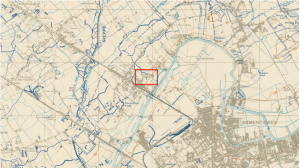
Pont de Nieppe on the 1918 map. Reproduced with the permission of the National Library of Scotland. https://maps.nls.uk/index.html
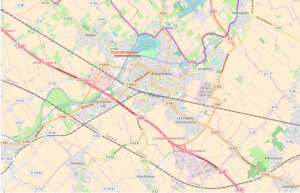
Modern day map showing Pont de Nieppe. © OpenStreetMap contributors. https://www.openstreetmap.org/copyright
It didn’t take long for news to filter through about the start of “Operation Michael” or the Kaiser’s spring offensive. The 113th RWF being deployed quickly to the area near the Somme had left the Armentieres area short of defensive cover at a time that was to prove very challenging for the allied armies.
Find out about our connection with Dr Page and an introduction to his diary here
20th March 1918 Wednesday
Returned to base, but bad news
All material produced or reproduced here and throughout this work is the sole copyright of the author and the family of Doctor D.C.M. Page MC.
“I returned to the 130th Field Ambulance for duty on the 20th March, and took charge of our Advanced Dressing Station at Houplines, situated in the cellars of what was once a mansion house. All the houses and factories round about were wrecked, and just masses of tumbled down bricks. The garden contained lots of daffodils and violets, and I had quite a cosy bed-sittingroom in one cellar furnished with carpets, 1 easy-chair, and containing a real fire-place.
News was coming through of the great Bosche push down south, the enemy claiming the capture of 26,000 men and 400 guns. Most depressing.”
After a great deal of increased activity in the area, the news of great German successes further south was a heavy blow to the moral of the men.
The surrender of Russia and their withdrawal from the conflict allowed the German high command to plan a decisive attack. Since 1914 neither side had gained any significant advances and now they had to act fast. The influx of many divisions from the east along with their equipment gave a new impetus.
Known as Operation Michael, the plan was to attack the British defended front to the south on the Somme. From there they would push through in a north westerly direction towards the sea cutting off the BEF, seizing the ports and allowing the flow of supplies once more from the sea. This in turn was to produce a tipping point in the war in favour of The Kaiser.
The need for speed was paramount, Germany knew only too well that the Americans were pouring men and infrastructure into the war. Another 840,000 were due to join those in France since 1917 with a total of over a million. This would pose a much more difficult if not impossible scenario and would most likely be Germany’s last chance of victory.
Initially much ground fell into German hands, including all the ground fought over at the Somme in 1916.
However, success would prove to be limited. German front line troops were not matched by the supply routes behind them. The logistics operation could not match the offensive and the front line began to lose its early momentum, practically stalling by late April. That signalled the beginning of the end for Germany and by August the Allies buoyed by the addition of up to 2 million newly arrived Americans regained the lost ground, culminating in defeat of the German Nation by November.
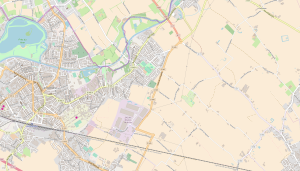
Modern day map showing Houplines to the west of Armentieres
© OpenStreetMap contributors https://www.openstreetmap.org/copyright
Find out about our connection with Dr Page and an introduction to his diary here
18th March 1918 Monday
Great Britain 5 Germany 0
All material produced or reproduced here and throughout this work is the sole copyright of the author and the family of Doctor D.C.M. Page MC.
“There was a great bombardment at 11.10 on the night of the 18th, the 12th Division carrying out a raid on the enemy trenches. Curiously enough the Huns raided our lines at six different places at the same time, but our boys got off best capturing 5 prisoners, and having only 3 men slightly wounded.”
Activity in the area seemed to be warming up somewhat. Behind the German lines a great deal of reinforcements were amassing as divisions were being released from the Eastern Front ahead of a large push destined for the next couple of days.
Find out about our connection with Dr Page and an introduction to his diary here
17th March 1918 Sunday
St. Patrick’s Day Goes With A Bang!
All material produced or reproduced here and throughout this work is the sole copyright of the author and the family of Doctor D.C.M. Page MC.
“Whilst I was visiting my friends of the 13th R.W.F. in Erquingham on Sunday 17th March, the Huns started shelling the place with nasty 15” high velocity shells. It was distinctly nasty whilst it lasted. He sent over six altogether, and managed to do a lot of damage to the village besides killing and wounding a number of our soldiers and civilians. I attended to several of the wounded. Several houses were smashed up, and a 4.5 limber was blown up by a direct hit in the main street, the horses and men being killed. Three motor ambulances were wrecked. The civilian population were in an awful state, and were seen rushing out of the village terror-stricken. The enemy did a lot of heavy shelling all around us all day, and at night I was called out to Windy Corner to attend to some wounded men. One was dead, but the others were alive, though very severely wounded. After dressing their wounds I got them away in an ambulance car, and was glad to leave a most uncomfortable spot, for shells were exploding all the time not too far off.”
The German 38cm high velocity shell was indeed a beast of a thing. Each one weighed in at a colossal 760 kgs and had a range of between 23 and 38 kilometres. Originally intended for the large guns of a battleship, their use was realised on the Western Front. Where possible these naval guns had permanent emplacements but then adapted to be used mounted on a railway truck, giving mobility to the dreadful weapon.
To send our man down to Windy Corner some 20 kms to the south west must have meant that senior medical help was in short supply down there, but Douglas was able to do his bit.
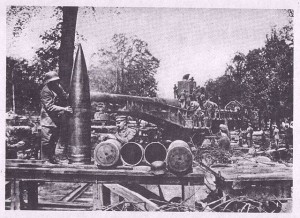
German artillery troops preparing the monster 38 cm gun clearly showing the size of a shell.
By Unknown – photo WW I, Public Domain, https://commons.wikimedia.org/w/index.php?curid=2986020
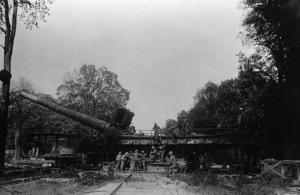
The rail mounted 38 cm SK L/45 known as the Langer Max high velocity cannon.
By Bundesarchiv, Bild 102-00153 / CC-BY-SA 3.0, CC BY-SA 3.0 de, https://commons.wikimedia.org/w/index.php?curid=5478715
Find out about our connection with Dr Page and an introduction to his diary here
15th March 1918 Friday
Gallows Humour after German Attack
All material produced or reproduced here and throughout this work is the sole copyright of the author and the family of Doctor D.C.M. Page MC.
“On the 15th the 16th R.W.F. raided the Huns taking six prisoners and a machine gun. It was a great sight to watch the barrage bursting on the enemy trenches, and the red S.O.S. lights bursting frantically on the front line. Just as I was going to retire for the night a shrapnel shell burst right overhead. There was a great stampede of everyone for the shelter of the farm cellar, but not another shell burst near us! It must have been a stray one. Anyhow, we all had a good laugh over the episode.”
The red S.O.S lights were rockets that were sent up to direct artillery fire. Yet another close call with a shrapnel shell scattering its deadly load above their heads. Now in his third year of hell on the Western Front Douglas survives another of countless close calls as the men scramble for cover. The laughs were clearly those of nervous relief.
Find out about our connection with Dr Page and an introduction to his diary here
12th March 1918 Tuesday
The Constant Shelling is Beginning to Play on The Nerves
All material produced or reproduced here and throughout this work is the sole copyright of the author and the family of Doctor D.C.M. Page MC.
“Next day (12th March) was another day of continuous shelling, which began to tell on one’s nerves. One of the officers, and a man from ‘D’ Battery, I had to evacuate suffering from shell-shock. They were very bad, and I felt very sorry for them. The Huns shelled Erquingham in the afternoon much to the consternation of the civilians. He also shelled Estaires and Bac-St Maur with high velocity shells. The 2nd Royal Welsh Fusiliers made a small raid, and captured one miserable Hun, who said that the battalion of German ‘Sturmtruppers’ who attacked us on the 10th March had been absolutely wiped out by our excellent gun fire. There were only twelve survivors, and he was one of them!”
The build-up of German offences was beginning to increase pressure on this part of the Western Front. Gradual withdrawal of German divisions from the Eastern Front, following Russia’s withdrawal meant reinforcements being drafted into the Western Front. The news that accurate British Artillery fire was taking effect buoyed moral.
Find out about our connection with Dr Page and an introduction to his diary here
11th March 1918 Monday
Douglas Gassed!
All material produced or reproduced here and throughout this work is the sole copyright of the author and the family of Doctor D.C.M. Page MC.
“Next morning (11th March) there was another great artillery duel at 5 o’clock. The enemy sent over a lot of gas shells near us as usual. One shell crashed into the mess kitchen of D Battery, killing the cook, and gassing five other men there. I rushed over as quickly as I heard about the affair, and found the place in an awful mess, and full of gas. I got a good few mouthfuls of it myself, before I realised it was so thick, and got on my gas mask.”
It must have been very difficult to carry out one’s duties whilst under attack from gas, The need to have your gas equipment ready to hand was demonstrated clearly that morning.
Find out about our connection with Dr Page and an introduction to his diary here
10th March 1918 Sunday
A Sleepless Night Under Heavy Fire
All material produced or reproduced here and throughout this work is the sole copyright of the author and the family of Doctor D.C.M. Page MC.
“Sunday, March 10th was an anxious day for us all, as word had leaked out that the Germans were to launch a huge attack against us that day. I was awake all the previous night during which the Huns continuously shelled all our back roads, especially around ‘Diarrhoea’ and ‘Laparotomy Corners’. He also put a lot of gas shells around us. About 5 o’clock there was a terrific bombardment on our left which lasted for an hour. The Germans raided the 13th Royal Welsh Fusiliers, and captured 1 offficer (Jones), and five men. They also killed 21 of our men and wounded 31 others. It was a nasty business.”
The mention of Diarrhoea and Laparotomy Corners, were clearly local names recognised by the men in the area but not included in the contemporary trench maps. Obviously named because of the conditions experienced in the locations.
The 13th RWF recorded the events thus:

Contains public sector information licensed under the Open Government Licence v3.0. http://discovery.nationalarchives.gov.uk/details/r/C7354150
Find out about our connection with Dr Page and an introduction to his diary here
